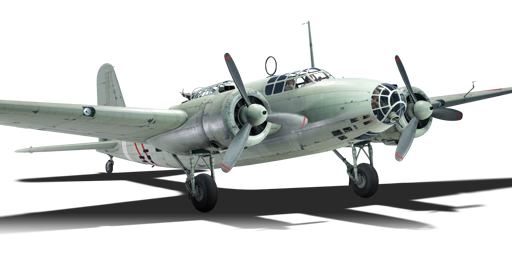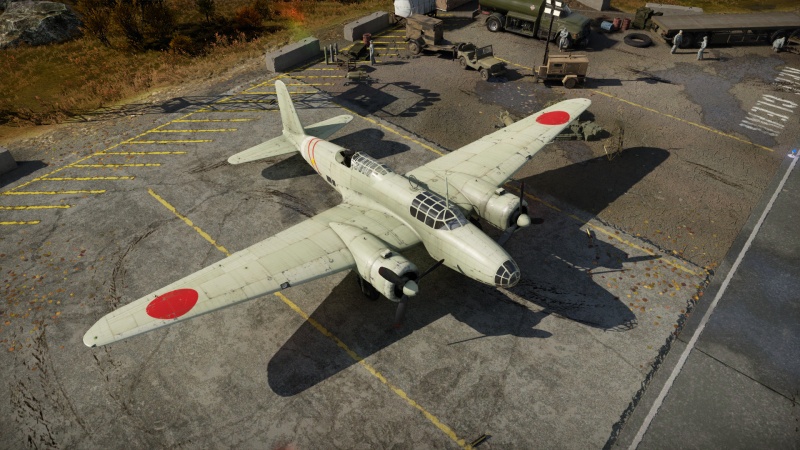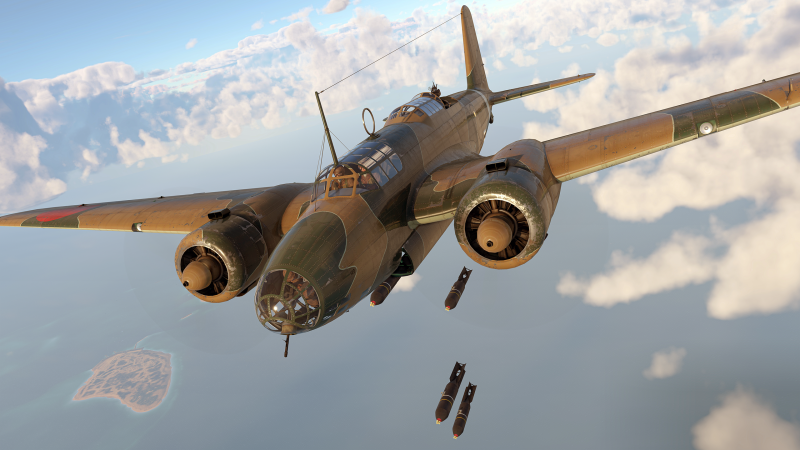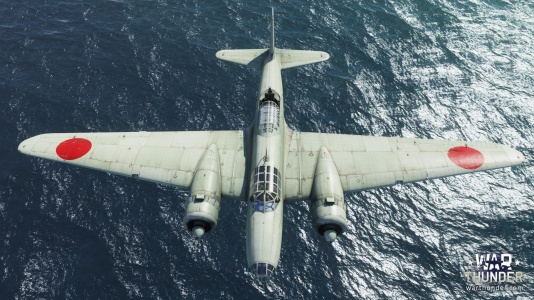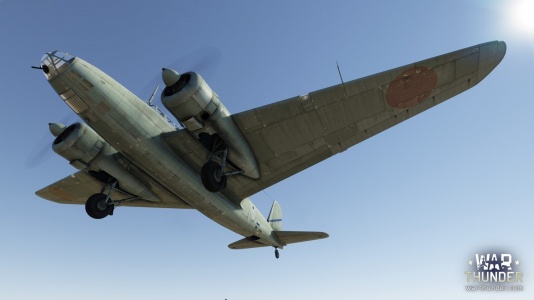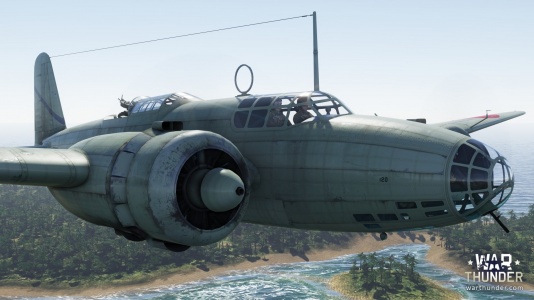Difference between revisions of "Ki-21-Ia"
bonfie69420 (talk | contribs) (→Description) (Tag: Visual edit) |
Colok76286 (talk | contribs) (Undo revision 159762 by U125863683 (talk)) |
||
| Line 10: | Line 10: | ||
== Description == | == Description == | ||
| − | <!-- ''In the description, the first part should be about the history of and the creation and combat usage of the aircraft, as well as its key features. In the second part, tell the reader about the aircraft in the game. Insert a screenshot of the vehicle, so that if the novice player does not remember the vehicle by name, he will immediately understand what kind of vehicle the article is talking about.'' --> | + | <!-- ''In the description, the first part should be about the history of and the creation and combat usage of the aircraft, as well as its key features. In the second part, tell the reader about the aircraft in the game. Insert a screenshot of the vehicle, so that if the novice player does not remember the vehicle by name, he will immediately understand what kind of vehicle the article is talking about.'' --> |
| − | + | The '''{{Specs|name}}''' is a rank {{Specs|rank}} Japanese bomber {{Battle-rating}}. It was introduced in [[Update 1.49 "Weapons of Victory"]]. | |
| + | |||
| + | T | ||
| + | |||
| + | === Flight performance === | ||
| + | {{Specs-Avia-Flight}} | ||
| + | <!-- ''Describe how the aircraft behaves in the air. Speed, manoeuvrability, acceleration and allowable loads - these are the most important characteristics of the vehicle.'' --> | ||
| + | |||
| + | {| class="wikitable" style="text-align:center" width="70%" | ||
| + | ! rowspan="2" | Characteristics | ||
| + | ! colspan="2" | Max Speed<br>(km/h at 400 m) | ||
| + | ! rowspan="2" | Max altitude<br>(metres) | ||
| + | ! colspan="2" | Turn time<br>(seconds) | ||
| + | ! colspan="2" | Rate of climb<br>(metres/second) | ||
| + | ! rowspan="2" | Take-off run<br>(metres) | ||
| + | |- | ||
| + | ! AB !! RB !! AB !! RB !! AB !! RB | ||
| + | |- | ||
| + | ! Stock | ||
| + | | 412 || 399 || rowspan="2" | {{Specs|ceiling}} || 14.7 || 15.3 || 3.1 || 3.1 || rowspan="2" | 600 | ||
| + | |- | ||
| + | ! Upgraded | ||
| + | | 453 || 432 || 13.6 || 14.0 || 9.8 || 5.9 | ||
| + | |- | ||
| + | |} | ||
| + | |||
| + | ==== Details ==== | ||
| + | {| class="wikitable" style="text-align:center" width="50%" | ||
| + | |- | ||
| + | ! colspan="5" | Features | ||
| + | |- | ||
| + | ! Combat flaps !! Take-off flaps !! Landing flaps !! Air brakes !! Arrestor gear | ||
| + | |- | ||
| + | | ✓ || ✓ || ✓ || X || X <!-- ✓ --> | ||
| + | |- | ||
| + | |} | ||
| + | |||
| + | {| class="wikitable" style="text-align:center" width="50%" | ||
| + | |- | ||
| + | ! colspan="7" | Limits | ||
| + | |- | ||
| + | ! rowspan="2" | Wings (km/h) | ||
| + | ! rowspan="2" | Gear (km/h) | ||
| + | ! colspan="3" | Flaps (km/h) | ||
| + | ! colspan="2" | Max Static G | ||
| + | |- | ||
| + | ! Combat !! Take-off !! Landing !! + !! - | ||
| + | |- | ||
| + | | {{Specs|destruction|body}} || {{Specs|destruction|gear}} || 428 || 399 || 250 || ~7 || ~2 | ||
| + | |- | ||
| + | |} | ||
| + | |||
| + | {| class="wikitable" style="text-align:center" | ||
| + | |- | ||
| + | ! colspan="4" | Optimal velocities (km/h) | ||
| + | |- | ||
| + | ! Ailerons !! Rudder !! Elevators !! Radiator | ||
| + | |- | ||
| + | | < 260 || < 260 || < 260 || > 320 | ||
| + | |- | ||
| + | |} | ||
| + | |||
| + | {| class="wikitable" style="text-align:center" | ||
| + | |- | ||
| + | ! colspan="3" | Compressor (RB/SB) | ||
| + | |- | ||
| + | ! colspan="3" | Setting 1 | ||
| + | |- | ||
| + | ! Optimal altitude | ||
| + | ! 100% Engine power | ||
| + | ! WEP Engine power | ||
| + | |- | ||
| + | | 3,700 m || 890 hp || 1,080 hp | ||
| + | |- | ||
| + | |} | ||
| + | |||
| + | === Survivability and armour === | ||
| + | {{Specs-Avia-Armour}} | ||
| + | <!-- ''Examine the survivability of the aircraft. Note how vulnerable the structure is and how secure the pilot is, whether the fuel tanks are armoured, etc. Describe the armour, if there is any, and also mention the vulnerability of other critical aircraft systems.'' --> | ||
| + | |||
| + | * No armour | ||
| + | * Self-sealing fuel tanks (2 in each wing, 2 in the mid-fuselage) | ||
| + | |||
| + | === Modifications and economy === | ||
| + | {{Specs-Economy}} | ||
| + | |||
| + | Being a bomber, speed is not necessarily an important attribute, however payload and defensive armament is. Upgrading the bombs allows for more target flexibility and damage potential while turret upgrades will help survivability. the turret belts and the "new turrets" upgrades are useful. The "new turrets" upgrade will allow you to fire the turrets for longer periods of time and having access to multiple ammunition belts is also helpful. The engine upgrades are also useful in that they will help you reach your target faster and will control engine temperature. Having all of the weapons upgrades will help drastically in unlocking the other modules on this aircraft. Getting the airframe module does help in survivability as it helps your plane's durability. | ||
| + | |||
| + | == Armaments == | ||
| + | {{Specs-Avia-Armaments}} | ||
| + | === Suspended armament === | ||
| + | {{Specs-Avia-Suspended}} | ||
| + | <!-- ''Describe the aircraft's suspended armament: additional cannons under the wings, bombs, rockets and torpedoes. This section is especially important for bombers and attackers. If there is no suspended weaponry remove this subsection.'' --> | ||
| + | {{main|Army Type 94 GPHE (50 kg)|Army Type 94 GPHE (100 kg)|Army Type 92 GPHE (250 kg)|Army Type 92 GPHE (500 kg)}} | ||
| + | |||
| + | The '''''{{PAGENAME}}''''' can be outfitted with the following ordnance: | ||
| + | |||
| + | * 20 x 50 kg Army Type 94 GPHE bombs (1,000 kg total) | ||
| + | * 10 x 100 kg Army Type 94 GPHE bombs (1,000 kg total) | ||
| + | * 4 x 250 kg Army Type 92 GPHE bombs (1,000 kg total) | ||
| + | * 2 x 500 kg Army Type 92 GPHE bombs (1,000 kg total) | ||
| + | |||
| + | === Defensive armament === | ||
| + | {{Specs-Avia-Defensive}} | ||
| + | <!-- ''Defensive armament with turret machine guns or cannons, crewed by gunners. Examine the number of gunners and what belts or drums are better to use. If defensive weaponry is not available, remove this subsection.'' --> | ||
| + | {{main|Te-1 (7.7 mm)|Type 89 'special' (7.7 mm)}} | ||
| + | |||
| + | The '''''{{PAGENAME}}''''' is defended by: | ||
| + | |||
| + | * 2 x 7.7 mm Type 89 'special' machine guns, dorsal turret (450 rpg = 900 total) | ||
| + | * 1 x 7.7 mm Te-1 machine gun, nose turret (483 rpg) | ||
| + | * 1 x 7.7 mm Te-1 machine gun, ventral turret (483 rpg) | ||
| + | |||
| + | == Usage in battles == | ||
| + | <!-- ''Describe the tactics of playing in the aircraft, the features of using aircraft in a team and advice on tactics. Refrain from creating a "guide" - do not impose a single point of view, but instead, give the reader food for thought. Examine the most dangerous enemies and give recommendations on fighting them. If necessary, note the specifics of the game in different modes (AB, RB, SB).'' --> | ||
| + | If attacked by fighters, it is important to remember and recognize the Ki-21's turning capabilities. It is actually possible to win lateral turn fights against fighters with this aircraft as she is one of the most manoeuvrable bombers if not the most manoeuvrable bomber in game. While the Ki-21's defensive firepower isn't going to deter enemies from attacking, they still can damage enemy planes. | ||
| + | |||
| + | This aircraft has the ability to hold up to 1,000 kg of bombs in several different variations: 20 x 50 kg, 10 x 100 kg, 4 x 250 kg, and 2 x 500 kg. Use the 20 x 50 kg or 10 x 100 kg bombs to attack light tanks and light pillboxes. They are not viable against bigger targets, since direct hits are needed to destroy. This loadout is particularly useful on maps that have an abundance of non-moving targets (light pillboxes) or lightly armoured targets (armoured cars or AA trucks for example). Use either of the 4 x 250 kg or 2 x 500 kg payload to destroy heavier targets such as medium tanks, pillboxes, destroyers, and cargo ships. | ||
| + | |||
| + | Although unconventional, this aircraft is a fantastic weapon if you want to bait the enemy. Ideally, you would want to attract a higher flying enemy down to you and to get into a turn fight. This way, depending on the enemy aircraft you can out manoeuvre and distract him while teammates fly down to finish him off. | ||
| + | |||
| + | You should avoid any plane with cannons as this plane, while it is reasonably durable, does not like to take hits from cannon rounds. The plane that should be feared the most is the [[LaGG-3-34]] which has the 37 mm cannon with the ''Air targets'' belts, as a single round from the 37 mm cannon will either cripple the Ki-21 or destroy it immediately. | ||
| + | |||
| + | === Manual Engine Control === | ||
| + | {| class="wikitable" style="text-align:center" | ||
| + | |- | ||
| + | ! colspan="7" | MEC elements | ||
| + | |- | ||
| + | ! rowspan="2" | Mixer | ||
| + | ! rowspan="2" | Pitch | ||
| + | ! colspan="3" | Radiator | ||
| + | ! rowspan="2" | Supercharger | ||
| + | ! rowspan="2" | Turbocharger | ||
| + | |- | ||
| + | ! Oil !! Water !! Type | ||
| + | |- | ||
| + | | Not controllable || Controllable<br>Not auto controlled || Controllable<br>Auto control available || Controllable<br>Auto control available || Separate || Not controllable<br>1 gear || Not controllable | ||
| + | |- | ||
| + | |} | ||
| + | |||
| + | === Pros and cons === | ||
| + | <!-- ''Summarise and briefly evaluate the vehicle in terms of its characteristics and combat effectiveness. Mark its pros and cons in the bulleted list. Try not to use more than 6 points for each of the characteristics. Avoid using categorical definitions such as "bad", "good" and the like - use substitutions with softer forms such as "inadequate" and "effective".'' --> | ||
| + | |||
| + | '''Pros:''' | ||
| + | |||
| + | * Very manoeuvrable | ||
| + | * Extensive bombload for a rank I Japanese bomber | ||
| + | * Decent cruising speed | ||
| + | * Durable, can take some hits | ||
| + | * Above average defensive armament for its BR | ||
| + | * Internal payload | ||
| + | |||
| + | '''Cons:''' | ||
| + | |||
| + | * Loses effectiveness with altitude | ||
| + | * No armour | ||
| + | * Defensive armament is still outclassed by many | ||
| + | * Falls quickly when attacked by multiple foes | ||
| + | * Head on attacks are usually fatal because of lack of protection for the pilots | ||
| + | * Gunners can be knocked out easily | ||
| + | |||
| + | == History == | ||
| + | <!-- ''Describe the history of the creation and combat usage of the aircraft in more detail than in the introduction. If the historical reference turns out to be too long, take it to a separate article, taking a link to the article about the vehicle and adding a block "/History" (example: <nowiki>https://wiki.warthunder.com/(Vehicle-name)/History</nowiki>) and add a link to it here using the <code>main</code> template. Be sure to reference text and sources by using <code><nowiki><ref></ref></nowiki></code>, as well as adding them at the end of the article with <code><nowiki><references /></nowiki></code>. This section may also include the vehicle's dev blog entry (if applicable) and the in-game encyclopedia description (under <code><nowiki>=== In-game description ===</nowiki></code>, also if applicable).'' --> | ||
| + | In 1936, the Imperial Japanese Army Air Service issued a requirement for a new heavy bomber to replace two previous models. This new heavy bomber had to have a crew of four to six men, a top speed of 400 km/h (250 mph), had to be able to carry a bomb load greater than 750 kg (1,650 lb), had to be able to climb to altitude in less than 8 minutes, and had to take off in less than 300 m (980 ft). The new bomber also had to utilize Nakajima Ha-5 or Mitsubishi Ha-6 engines and had to contain specific models of radios, among many other specifications. These requirements were quite extensive and there weren't many heavy bombers in existence at the time that could perform at these standards. | ||
| + | |||
| + | Mitsubishi produced two prototypes of the Ki-21 to meet these standards. This new design proved superior to the design submitted by Kawasaki but was nearly on-par with Nakajima's submission. In early tests, Nakajima's prototype, the Ki-19 had more reliable engines and a better bombing platform, while the Ki-21 had better overall performance. In later rounds of testing, after the Army Air Service ordered modifications to be made to both prototypes, the Ki-21 came out on top and won the Army's contract for a heavy bomber. | ||
| + | |||
| + | Production began in November 1937 and the bomber began to see action in August 1938. The specific variant seen in game, the Ki-21-Ia, was used on the Chinese front during the Second Sino-Japanese War and against the Soviet Union during the Nomohan Incident. The Ki-21 would start off successfully during early World War 2, but by the end of World War 2 it was relegated to second line duties or kamikaze attacks. Overall 2,064 Mitsubishi Ki-21s of all variants were produced for the Japanese Army Air Force. | ||
== Media == | == Media == | ||
Revision as of 19:29, 27 March 2023
| This page is about the Japanese bomber Ki-21-Ia. For the gift version, see Ki-21-I hei. |
Contents
Description
The Ki-21-Ia is a rank I Japanese bomber with a battle rating of 2.0 (AB) and 1.7 (RB/SB). It was introduced in Update 1.49 "Weapons of Victory".
T
Flight performance
| Characteristics | Max Speed (km/h at 400 m) |
Max altitude (metres) |
Turn time (seconds) |
Rate of climb (metres/second) |
Take-off run (metres) | |||
|---|---|---|---|---|---|---|---|---|
| AB | RB | AB | RB | AB | RB | |||
| Stock | 412 | 399 | 8600 | 14.7 | 15.3 | 3.1 | 3.1 | 600 |
| Upgraded | 453 | 432 | 13.6 | 14.0 | 9.8 | 5.9 | ||
Details
| Features | ||||
|---|---|---|---|---|
| Combat flaps | Take-off flaps | Landing flaps | Air brakes | Arrestor gear |
| ✓ | ✓ | ✓ | X | X |
| Limits | ||||||
|---|---|---|---|---|---|---|
| Wings (km/h) | Gear (km/h) | Flaps (km/h) | Max Static G | |||
| Combat | Take-off | Landing | + | - | ||
| 540 | 380 | 428 | 399 | 250 | ~7 | ~2 |
| Optimal velocities (km/h) | |||
|---|---|---|---|
| Ailerons | Rudder | Elevators | Radiator |
| < 260 | < 260 | < 260 | > 320 |
| Compressor (RB/SB) | ||
|---|---|---|
| Setting 1 | ||
| Optimal altitude | 100% Engine power | WEP Engine power |
| 3,700 m | 890 hp | 1,080 hp |
Survivability and armour
- No armour
- Self-sealing fuel tanks (2 in each wing, 2 in the mid-fuselage)
Modifications and economy
Being a bomber, speed is not necessarily an important attribute, however payload and defensive armament is. Upgrading the bombs allows for more target flexibility and damage potential while turret upgrades will help survivability. the turret belts and the "new turrets" upgrades are useful. The "new turrets" upgrade will allow you to fire the turrets for longer periods of time and having access to multiple ammunition belts is also helpful. The engine upgrades are also useful in that they will help you reach your target faster and will control engine temperature. Having all of the weapons upgrades will help drastically in unlocking the other modules on this aircraft. Getting the airframe module does help in survivability as it helps your plane's durability.
Armaments
Suspended armament
The Ki-21-Ia can be outfitted with the following ordnance:
- 20 x 50 kg Army Type 94 GPHE bombs (1,000 kg total)
- 10 x 100 kg Army Type 94 GPHE bombs (1,000 kg total)
- 4 x 250 kg Army Type 92 GPHE bombs (1,000 kg total)
- 2 x 500 kg Army Type 92 GPHE bombs (1,000 kg total)
Defensive armament
The Ki-21-Ia is defended by:
- 2 x 7.7 mm Type 89 'special' machine guns, dorsal turret (450 rpg = 900 total)
- 1 x 7.7 mm Te-1 machine gun, nose turret (483 rpg)
- 1 x 7.7 mm Te-1 machine gun, ventral turret (483 rpg)
Usage in battles
If attacked by fighters, it is important to remember and recognize the Ki-21's turning capabilities. It is actually possible to win lateral turn fights against fighters with this aircraft as she is one of the most manoeuvrable bombers if not the most manoeuvrable bomber in game. While the Ki-21's defensive firepower isn't going to deter enemies from attacking, they still can damage enemy planes.
This aircraft has the ability to hold up to 1,000 kg of bombs in several different variations: 20 x 50 kg, 10 x 100 kg, 4 x 250 kg, and 2 x 500 kg. Use the 20 x 50 kg or 10 x 100 kg bombs to attack light tanks and light pillboxes. They are not viable against bigger targets, since direct hits are needed to destroy. This loadout is particularly useful on maps that have an abundance of non-moving targets (light pillboxes) or lightly armoured targets (armoured cars or AA trucks for example). Use either of the 4 x 250 kg or 2 x 500 kg payload to destroy heavier targets such as medium tanks, pillboxes, destroyers, and cargo ships.
Although unconventional, this aircraft is a fantastic weapon if you want to bait the enemy. Ideally, you would want to attract a higher flying enemy down to you and to get into a turn fight. This way, depending on the enemy aircraft you can out manoeuvre and distract him while teammates fly down to finish him off.
You should avoid any plane with cannons as this plane, while it is reasonably durable, does not like to take hits from cannon rounds. The plane that should be feared the most is the LaGG-3-34 which has the 37 mm cannon with the Air targets belts, as a single round from the 37 mm cannon will either cripple the Ki-21 or destroy it immediately.
Manual Engine Control
| MEC elements | ||||||
|---|---|---|---|---|---|---|
| Mixer | Pitch | Radiator | Supercharger | Turbocharger | ||
| Oil | Water | Type | ||||
| Not controllable | Controllable Not auto controlled |
Controllable Auto control available |
Controllable Auto control available |
Separate | Not controllable 1 gear |
Not controllable |
Pros and cons
Pros:
- Very manoeuvrable
- Extensive bombload for a rank I Japanese bomber
- Decent cruising speed
- Durable, can take some hits
- Above average defensive armament for its BR
- Internal payload
Cons:
- Loses effectiveness with altitude
- No armour
- Defensive armament is still outclassed by many
- Falls quickly when attacked by multiple foes
- Head on attacks are usually fatal because of lack of protection for the pilots
- Gunners can be knocked out easily
History
In 1936, the Imperial Japanese Army Air Service issued a requirement for a new heavy bomber to replace two previous models. This new heavy bomber had to have a crew of four to six men, a top speed of 400 km/h (250 mph), had to be able to carry a bomb load greater than 750 kg (1,650 lb), had to be able to climb to altitude in less than 8 minutes, and had to take off in less than 300 m (980 ft). The new bomber also had to utilize Nakajima Ha-5 or Mitsubishi Ha-6 engines and had to contain specific models of radios, among many other specifications. These requirements were quite extensive and there weren't many heavy bombers in existence at the time that could perform at these standards.
Mitsubishi produced two prototypes of the Ki-21 to meet these standards. This new design proved superior to the design submitted by Kawasaki but was nearly on-par with Nakajima's submission. In early tests, Nakajima's prototype, the Ki-19 had more reliable engines and a better bombing platform, while the Ki-21 had better overall performance. In later rounds of testing, after the Army Air Service ordered modifications to be made to both prototypes, the Ki-21 came out on top and won the Army's contract for a heavy bomber.
Production began in November 1937 and the bomber began to see action in August 1938. The specific variant seen in game, the Ki-21-Ia, was used on the Chinese front during the Second Sino-Japanese War and against the Soviet Union during the Nomohan Incident. The Ki-21 would start off successfully during early World War 2, but by the end of World War 2 it was relegated to second line duties or kamikaze attacks. Overall 2,064 Mitsubishi Ki-21s of all variants were produced for the Japanese Army Air Force.
Media
- Skins
- Videos
See also
Links to the articles on the War Thunder Wiki that you think will be useful for the reader, for example:
- reference to the series of the aircraft;
- links to approximate analogues of other nations and research trees.
External links
| Mitsubishi Company (三菱商会) | |
|---|---|
| Fighters | A5M4 · Hagiri's A5M4 |
| A6M2 mod. 11 · A6M2 · A6M3 · A6M3 mod. 22 · A6M3 mod. 22Ko · A6M5 · A6M5 Ko · A6M5 otsu · A6M5 Hei · A6M6c | |
| A7M1 (NK9H) · A7M2 | |
| J2M2 · J2M3 · J2M4 Kai · J2M5 · J2M5 (30 mm) | |
| Hydroplanes | F1M2 |
| Interceptors | Ki-83 · Ki-109 |
| Bombers | G4M1 |
| Ki-21-Ia · Ki-21-I hei · Ki-67-I Ko · Ki-67-I otsu | |
| Jet Fighters | Ki-200 |
| Captured | ▃A6M2 · ␗A6M2 |
| See also | Mitsubishi Heavy Industries, Ltd. (Post-War) |
| Japan bombers | |
|---|---|
| Navy | |
| Carrier-based attack bomber | |
| B5N | B5N2 |
| B6N | B6N1 · B6N2 · B6N2a |
| B7A | B7A2 · B7A2 (Homare 23) |
| Carrier-based dive bomber | |
| D3A | D3A1 |
| D4Y | D4Y1 · D4Y2 · D4Y3 Ko |
| Shipboard Observation seaplane | |
| F1M | F1M2 |
| Land-based Attack bomber | |
| G4M | G4M1 |
| G5N | G5N1 |
| G8N | G8N1 |
| Flying boat | |
| H6K | H6K4 |
| H8K | H8K2 · H8K3 |
| Land-based Bomber | |
| P1Y | P1Y1 |
| Army | |
| Light | Ki-32 |
| Ki-48-II otsu | |
| Heavy | Ki-21-Ia · Ki-21-I hei |
| Ki-49-I · Ki-49-IIa · Ki-49-IIb · Ki-49-IIb/L | |
| Ki-67-I Ko · Ki-67-I otsu | |
| Other countries | ▅B-17E |


